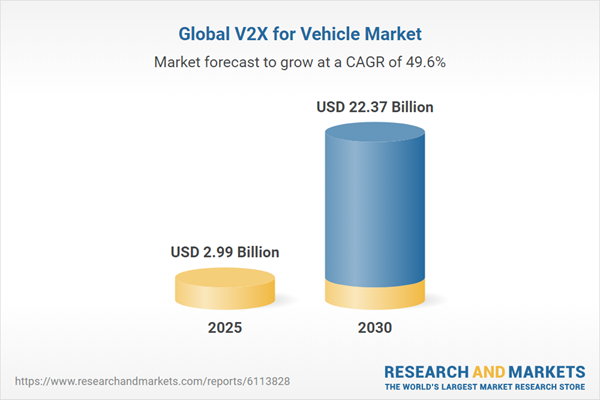The Vehicle-to-Everything (V2X) market is experiencing significant growth driven by the need to enhance human-vehicle interaction, improve driving efficiency, and ensure road safety. V2X systems facilitate seamless communication between vehicles, infrastructure, networks, and pedestrians, categorized into four types: Vehicle-to-Vehicle (V2V), Vehicle-to-Infrastructure (V2I), Vehicle-to-Network (V2N), and Vehicle-to-Pedestrian (V2P). These systems address approximately 4.5 million crashes, representing 81% of multi-vehicle, unimpaired crash types, by improving traffic flow, reducing environmental impact, and providing critical traveler information.
Market Drivers and Key Players
The demand for safer and more efficient driving practices is fueling V2X market expansion. Key industry players are advancing V2X technologies to meet these needs. Qualcomm’s Cellular V2X (C-V2X) technology enhances vehicle interaction with other vehicles, infrastructure, and pedestrians, leveraging 3GPP Release 14 LTE and future 5G networks for reliable, time-sensitive safety communications, even without mobile network coverage. Similarly, DANLAW’s RouteLink RSU product warns drivers of adverse conditions, prioritizing safety and mobility. These innovations underscore the market’s focus on improving driving experiences through advanced communication systems.Market Segmentation Analysis
By Solution
The V2X market is divided into hardware and software solutions. Software-based V2X systems dominate due to their pre-installation in new vehicles, meeting consumer demand for integrated, efficient technologies.By Technology
The market splits into WLAN-based (DSRC) and cellular-based technologies. WLAN-based V2X, standardized as Dedicated Short-Range Communications (DSRC), holds greater demand due to its established framework and reliability compared to cellular-based alternatives.By Communication Type
V2V communication leads the market share due to its critical role in enabling safer and more efficient driving. V2I, V2N, and V2P also contribute significantly, supporting diverse applications for enhanced road safety and traffic management.By Vehicle Type
Passenger vehicles dominate the V2X market, driven by higher production and demand compared to light and heavy commercial vehicles, reflecting the widespread adoption of V2X in consumer cars.By Application
Forward collision warning holds a significant market share, addressing a common on-road scenario. Lane change and blind-spot warnings also command notable shares, reflecting their importance in preventing accidents and enhancing driver awareness. Other applications include emergency brake light warnings, intersection movement assistance, emergency vehicle notifications, roadworks warnings, and platooning.By Geography
North America leads the V2X market, driven by robust automobile production and growing demand for advanced driver-vehicle interaction systems. Other regions, including Europe, Asia-Pacific, Middle East & Africa, and South America, also contribute to the market’s global expansion.Key Product Offerings
Continental Cellular V2X (C-V2X): Enables connectivity over LTE and future 5G networks, supporting direct vehicle communication with other road users and infrastructure, even in areas without mobile coverage.Qualcomm C-V2X: Provides 360-degree non-line-of-sight awareness through direct (V2V, V2I, V2P) and network-based communications in the 5.9 GHz ITS spectrum, enhancing safety and supporting autonomous driving.
The V2X market is poised for continued growth as technological advancements and increasing safety demands drive adoption across vehicle types and regions.
Key Benefits of this Report:
- Insightful Analysis: Gain detailed market insights covering major as well as emerging geographical regions, focusing on customer segments, government policies and socio-economic factors, consumer preferences, industry verticals, and other sub-segments.
- Competitive Landscape: Understand the strategic maneuvers employed by key players globally to understand possible market penetration with the correct strategy.
- Market Drivers & Future Trends: Explore the dynamic factors and pivotal market trends and how they will shape future market developments.
- Actionable Recommendations: Utilize the insights to exercise strategic decisions to uncover new business streams and revenues in a dynamic environment.
- Caters to a Wide Audience: Beneficial and cost-effective for startups, research institutions, consultants, SMEs, and large enterprises.
What do businesses use our reports for?
Industry and Market Insights, Opportunity Assessment, Product Demand Forecasting, Market Entry Strategy, Geographical Expansion, Capital Investment Decisions, Regulatory Framework & Implications, New Product Development, Competitive IntelligenceReport Coverage:
- Historical data from 2022 to 2024 & forecast data from 2025 to 2030
- Growth Opportunities, Challenges, Supply Chain Outlook, Regulatory Framework, and Trend Analysis
- Competitive Positioning, Strategies, and Market Share Analysis
- Revenue Growth and Forecast Assessment of segments and regions including countries
- Company Profiling (Strategies, Products, Financial Information, and Key Developments among others).
Segmentation
By Solution
- Hardware
- Softwareand Services
By Technology
- WLAN
- Cellular
By Communication Type
- V2V (vehicle to vehicle)
- V2I (vehicle to infrastructure)
- V2N (vehicle to network)
- V2P (vehicle to pedestrian)
By Vehicle Type
- Passenger Vehicle
- Light Commercial Vehicle
- Heavy Commercial Vehicle
By Application
- Forward Collision Warning
- Lane Change Warning/Blind Spot Warning
- Emergency Electric Brake Light Warning
- Others
By Geography
- North America
- USA
- Canada
- Mexico
- South America
- Brazil
- Argentina
- Others
- Europe
- Germany
- France
- United Kingdom
- Spain
- Others
- Middle East and Africa
- Saudi Arabia
- Israel
- UAE
- Others
- Asia Pacific
- China
- Japan
- South Korea
- India
- Taiwan
- Thailand
- Indonesia
- Others
Table of Contents
Companies Mentioned
- Continental AG
- Qualcomm Incorporated
- Samsung Electronics Co., Ltd.
- Marben Products
- Commsignia
- Huawei Technologies Co., Ltd
- Danlaw, Inc
- Robert Bosch GmbH
- Autotalks Ltd.
- NXP Semiconductors
- Infineon Technologies AG
- Denso Corporation
Table Information
| Report Attribute | Details |
|---|---|
| No. of Pages | 155 |
| Published | June 2025 |
| Forecast Period | 2025 - 2030 |
| Estimated Market Value ( USD | $ 2.99 Billion |
| Forecasted Market Value ( USD | $ 22.37 Billion |
| Compound Annual Growth Rate | 49.5% |
| Regions Covered | Global |
| No. of Companies Mentioned | 12 |









